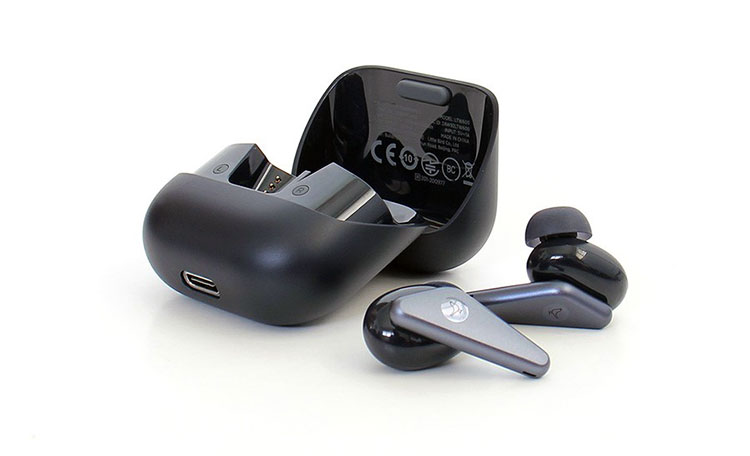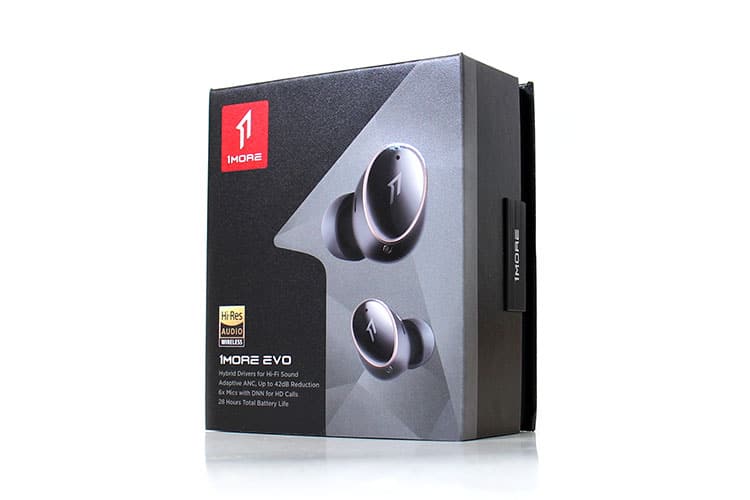Wireless Performance
Stability and Range
I must admit that the 1More EVO TWS scored high with me on the long-range test. I could not remember a TWS set that gave me a longer range in particular when operating at the LDAC signal level.
I usually get around 18 feet max from the source on LDAC. Beyond that distance, the common TWS set suffers massive breakup and disconnection. The EVO went out beyond 37 feet before the signal became unstable.
Another thing I noticed about the 1more EVO TWS was the easy pairing and the very fast connection once you initially pair and once you open the cradle door. So, stability and range both exceeded my expectations. I never experienced any dropouts either.
Latency
Here’s another area that the 1More EVO did very well. Perhaps a better-trained eye could pick up on the minuscule amount of latency present in this set but I could not. It seemed better than average compared to other sets. You could watch a movie with lots of dialogue and not feel as if the movie was being translated.
Lip-synching was on point and the good part is that this characteristic seems common to this set since you don’t have to go in and set a sporting mode or low latency mode within the app. It just naturally performed almost stellar in scope.
Select Comparisons
Edifier NeoBuds Pro
Price $129.00
Technical
If you’re on a 130-dollar budget and are looking for a TWS that can handle LDAC then the NeoBuds are certainly a good candidate to throw into the short list of the best-sounding TWS models around and, like the EVO, below the 200-dollar mark.
These two models have many similarities and one of course is the LDAC implementation. But there’s also a similar six-microphone setup and touch controls with an assignable touch control system.
Another similarity is that they both sport a hybrid driver configuration that consists of a dynamic driver for the bass and midrange plus an additional balanced armature made by Knowles for the high-frequency portion.
Design
The most obvious visual difference from the EVO is with the earbuds and the overall aesthetics in design. The NeoBuds employ a ball and stem design which many people like due to the stem itself giving you an area of leverage that you can hold on to plus the particular design anchors itself inside the ear canal well.
The cradle is also different in design and appearance. The NeoBuds Pro has an egg-shaped design with LEDs upfront. The LEDs resemble spaceship lights and indicate charging status and battery life. The case design in general has a UFO-looking appearance.
The only con is that the cradle is made mostly of polymer materials and doesn’t have a tough skin like the 1more EVO cradle. There’s only a small, brushed metal laminate up front. Similarly, it has a polymer hinge.
Performance
Sound quality-wise, the EVO might have a small edge over the NeoBuds but not by much and it seems it’s mostly due to the extra frequency extension.
The EVO just has a better frequency extension overall and it could just be due to the 5.2 radio which takes better advantage of the 24-bit stream capability. The NeoBuds run on a 5.0 radio.
Both these models have a 7kHz peak but it’s more prominent on the EVO. The peak seems harsher on the NeoBuds but the one thing that the NeoBuds can probably do best is detail retrieval but only by a very small margin.
Both these sets presented a clean top end which is absent of noise more common with traditional and first-generation TWS models. The EVO sound characteristics seem to portray more weight while the NeoBuds seem to paint a better sense of spaciousness.
Libratone AIR+ 2
Price $229.00
Technical
The Libratone Air+ 2 seems to be a TWS that focuses on the latest tech like 5.2 BT and advanced WLCSP chips. The one employed here is the Qualcomm QCC5141. The AIR+2 should have the latest tech since the asking price is quite high.
Libratone seems to be more liberal when it comes to product details and not only do they disclose the electronic components and the drivers involved but they also carry an IPX54 rating.
The funny thing is that I cannot remember any mention of a water resistance level rating from 1More.
Design
The AIR+ 2 uses a ball and stem design similar to the NeoBuds but the ball is more like a bean shape. Just the same, this design tends to anchor itself better but the one aspect I could leave behind is the tip mounting system. The Libratone AIR+ 2 set tip mount is composed of a tiny rim on the border of the bean-shaped earbud.
This particular design makes it hard for the end user to purchase and install aftermarket tips and once again with a rather high asking price Libratone only gives you 3 sets of tips.
Smaller ears will benefit from the design because the problem lies in that the tips are too short for me.
But my main gripe with the tip selection issue is that I was able to fit some foam tips and preferred the sound signature with them instead of the stock tips but the lip would not hold on to them.
So, there is room for improvement there. However, that design aspect keeps the buyer from experimenting with other tips and that’s a con in my view.
Performance
From within this comparison, the one with the most neutral characterized sound signature is certainly the AIR+ 2. The overall sound signature seems soft-natured compared to the EVO with just a small amount of impactfulness that comes from the low end.
The AIR+ 2 low end does take a sharp dive below 30Hz while the EVO remains solid below 20Hz and has the best bass extension of the group that could reach 17Hz. The high frequencies are also better portrayed since the EVO can reach 16kHz while the AIR+ 2 can only reach around 12kHz max before it dives.
One category I have to put the AIR+ 2 upfront in is the amount of width and size of the soundstage which seems larger in scope and dimension on the AIR+ 2.

Klipsch T5 II True Wireless ANC
Price $149.00
Technical
By specifications alone, you might be fooled into assuming that the Klipsch T5 II True Wireless ANC doesn’t perform well because it only employs a single 5.8mm dynamic drive. The size itself might make some think that this set is overpriced.
However, once you employ the DIRAC setting you will question your thinking. Even though this TWS has no LDAC capability like the EVO it can operate on aptX plus is capable of running on SBC and AAC and with the DIRAC employed you can expect decent sound quality.
Design
Most of the Klipsch T5 II ANC value is evident in the robust construction, the attention to detail, and the overall weight of the package. It is a handsome set indeed.
The Klipsch T5 II ANC is a TWS that construction-wise was made with the tightest tolerances second to perhaps the Libratone AIR+ 2. The cradle opens sideways similar to the old Zippo butane lighters. The construction is also robust and is the heaviest set overall.
The benefit of that lies in the quality construction, and all-metal design including the all-metal hinges with earbuds that also fall into an uncommon category by employing an uncommon shape but are comfortable, nonetheless.
Performance
The Klipsch T5 II ANC underperforms drastically sound-wise until you activate the DIRAC within the Klipsch app. The stock sound can be described as thin and lifeless. But once you press that switch, life comes back into the mix. The change is quite drastic.
For those who don’t know, DIRAC is a company that takes a sound-producing device, conducts a bunch of sonic tests, and comes up with a DSP-corrected configuration that is tailored to that particular unit. It might sound like a fancy equalization method but it involves implementing phase and timing correction as well.
So, while the DIRAC system implements a custom DSP setting, it’s only one set. The Sound IQ could do something similar in that it improves the stock sound signature but it’s personalized and you could also store many set preferences. That’s an undeniable benefit over one DSP preset.
Our Verdict
The 1MORE EVO TWS has become one of my favorite TWS models at this price range and you could even throw in some higher-tier models into that bottom list. The LDAC makes a difference here together with the hybrid dual driver setup that caters to sound quality over all else.
Of course, they are not monitoring tools and have a colored sound signature and if you prefer sterile and analytical then you might not like these much. I like them because of the fun sound signature that does well when you want to push some boundaries and just have some fun.
You could still employ the Sound ID feature and make them sound closer to your personal preference. So along with that versatility level, a decent app set, features, and sound quality, I would most certainly consider this TWS if it falls within your budget.
1MORE EVO Technical Specifications
- Model: EH902
- Earbud weight: 7g
- Case Weight: 9 g
- Gross Weight: 3 g
- Earbud Dimension: 03 x 20.69 X 25.11 mm
- Case Dimensions: 60 x 28.61 x 38.65 mm
- Earbud Battery Capacity (Single): 48 mAh
- Case Battery Capacity: 450 mAh
- Earbuds Charging Time: 1 hour
- Case Charging Time (Wired): 2 hours
- Playtime* (ANC Off): Earbuds Fully Charged Music Playback: 5 hours
- Case and Earbuds Fully Charged Music playback: 20 hours
- Playtime* (ANC On): Earbuds Fully Charged Music Playback: 8 hours
- Case and Earbuds Fully Charged Music playback: 28 hours
- Speaker Impedance: 32 Ω
- Bluetooth Range: 10m (Open space)
- Bluetooth Version: Bluetooth® 5.2
- Bluetooth Protocols: HFP / A2DP / AVRCP
- Input: 5V 1A
- Working Temperature: 0℃ ~ 45℃
- Frequency Range: 400 GHz ~ 2.4835 GHz





